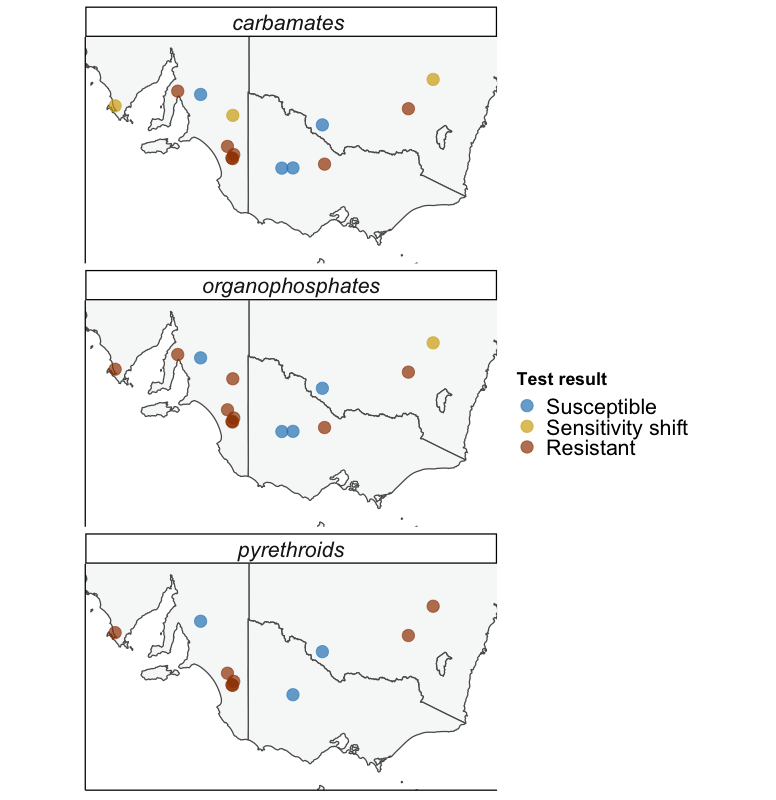As autumn approaches, growers will encounter a greater risk of bluegreen aphid outbreaks in legume crops.
The emergence and spread of insecticide resistance in bluegreen aphid may make controlling these outbreaks more challenging than in previous years.
In this article, we report on new research that shows resistance in bluegreen aphid may have spread further across south-eastern Australia than previously recognised.
First-of-its-kind insecticide resistance
The bluegreen aphid (Acyrthosiphon kondoi) is a pest of lucerne, pulses, medics, clovers, and pastures. Outbreaks of this tiny pest are most common in spring and autumn, where they damage plants by feeding on foliage and spreading plant viruses.
To control bluegreen aphid, growers routinely rely on carbamates and organophosphates. Until recently, these were the only chemical groups registered for bluegreen aphid management in most crops, contributing to a strong and consistent selection pressure to evolve resistance to these two chemical groups.
Indeed, in 2018, reports emerged from New South Wales and South Australia that insecticide sprays no longer provided satisfactory control.
Following these control failures, our 2021/22 lab studies confirmed that some bluegreen aphid populations in South Australia and NSW had evolved resistance to most chemicals registered and routinely used to control them (carbamates, organophosphate, and synthetic pyrethroids).
These were the first confirmed cases of insecticide resistance in bluegreen aphid, worldwide.
Key unknowns remain about what this first-of-its-kind evolutionary emergence means for management, including the risk of future control failures, where resistant strains have spread, and the long-term efficacy of other insecticides used in bluegreen aphid control.
A new project researching insecticide resistance
Cesar Australia and Lucerne Australia have commenced parallel research projects, with investment from AgriFutures Australia and the GRDC, to help pasture seed and pulse growers manage insecticide resistance in bluegreen aphid. To do so, we are gathering information on these resistant populations, including where they have spread and what crop types they are present in.
Beginning in Spring 2022, lead research scientist Dr. Evatt Chirgwin and his team have been collecting bluegreen aphid populations originating from across southern Australia. Many of these populations were obtained with the help of growers and agronomists – who posted bluegreen aphid samples from their paddocks to Cesar Australia’s lab. These aphids were then used in a series of chemical bioassays to determine resistance levels to the chemical groups where resistance has previously arisen in bluegreen aphids: pirimicarb (carbamate) and chlorpyrifos (organophosphates), and alpha-cypermethrin (synthetic pyrethroids).
Resistance has spread into new areas
Currently, the team has tested eleven new aphid populations. Of these eleven, seven populations showed significant levels of insecticide resistance to organophosphates and/or carbamates.
Our findings suggest insecticide resistance in bluegreen aphid has spread much further than previously reported.
Most notably, resistance was found in Victoria for the first time and has spread further west (the Eyre Peninsula) than previously recorded.
New resistant populations were also discovered in NSW.
Worryingly, cases of resistance were discovered in multiple paddocks with no history of control failure, suggesting resistant strains may have moved undetected into some new areas.

Management advice
Managing insecticide resistance in pests can be difficult, particularly with the risk of damage that comes with infestations of bluegreen aphid. But the increasing evidence of resistance emphasises the importance of giving extra care to long-term thinking in pest management.
Continual use of organophosphates, carbamates and pyrethroids will continue to encourage the development of resistance in bluegreen aphids. Growers are highly encouraged to reduce their usage of these chemicals.
Alternative chemicals are available for some crops. Sulfoxaflor (Transform) is registered for use on bluegreen aphid in pulses, and has recently been registered for lucerne. Flonicamid (MainMan) is under a limited emergency permit to control insecticide resistant bluegreen aphid in the later stages of lucerne seed production.
As part of reducing pesticides, growers can utilise the GRDC crop aphids back pocket guide to identify aphids, as management recommendations vary per species.
It’s recommended that green bridges be managed prior to sowing new crops to prevent outbreaks, or using bluegreen resistance cultivars in areas where bluegreen aphid is a high risk.
Natural enemies can also help suppress aphids, and evidence is pointing towards beneficials such as ladybirds, parasitoid wasps, hoverflies, and lacewings assisting in keeping bluegreen aphid numbers in check. To this end, Cesar will be undertaking further research to identify the presence and diversity of natural enemies attacking bluegreen populations, and developing tools that support growers in maintaining beneficials, such as the beneficials chemical toxicology table.
To deliver the best outcome for growers, we need your help!
There are big plans in the works for our research in 2023, including completing further surveillance bioassays and collecting new populations of bluegreen aphid for resistance testing.
We’re asking for assistance from growers and producers across Australia to help us map the spread of insecticide resistance in bluegreen aphid.
If you’re having trouble controlling bluegreen aphid with insecticides, or have a suspicion resistance in bluegreen aphid is lurking in your region, you can send us an aphid sample for free testing. Not only will you receive your results, but your help will allow us to provide regional and seasonal recommendations (e.g., which chemicals are most effective) for bluegreen aphid control and help prevent future resistance.
This autumn, we are particularly targeting bluegreen aphid from white clover crops in South Australia and Tasmania and also from pulses crops in from NSW.
Simply follow the procedure outlined in the aphid collection guidelines. For information on collecting and posting samples, please contact Dr Evatt Chirgwin (email: echirgwin@cesaraustralia.com or phone: 0487292556).
Want to know more?
You can find more information on bluegreen aphids, economic thresholds and management recommendations on PestNotes or in this video.
Acknowledgements
This article was developed as part of funding from AgriFutures Australia and the GRDC, This work is led by Cesar Australia in collaboration with Lucerne Australia. We thank the growers and agronomists who assisted with sample collections and chemical history information.
Cover image: Photo by Evatt Chirgwin, Cesar Australia





